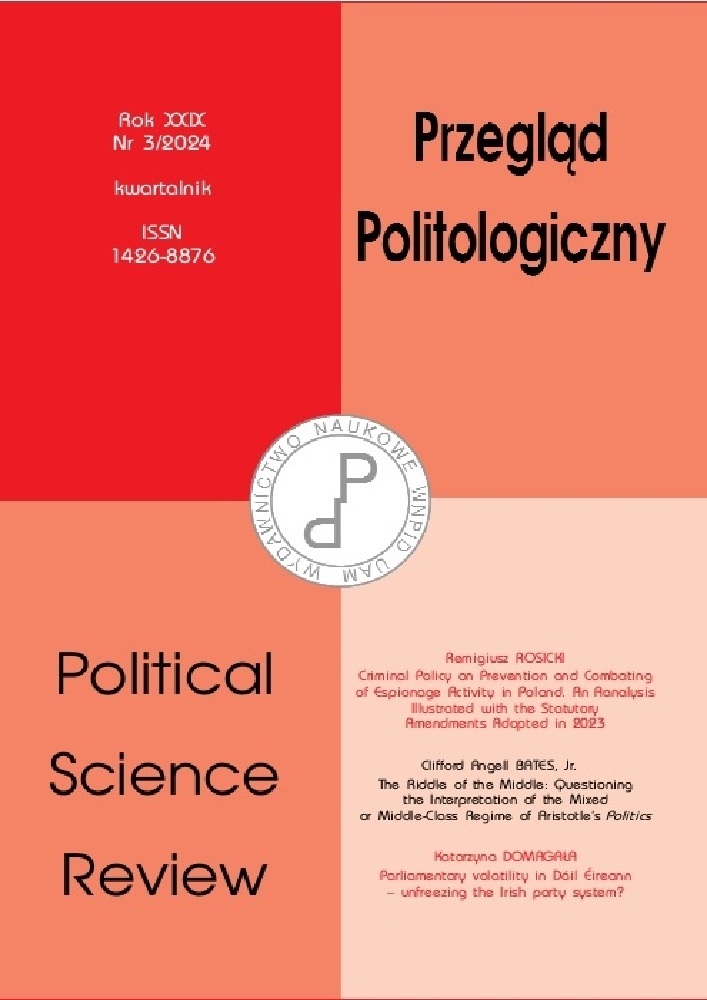Abstrakt
Niniejszy artykuł ma na celu analizę geopolitycznych wymiarów przejścia na odnawialne źródła energii w świetle międzynarodowej konkurencji o zabezpieczenie dostępu do metali ziem rzadkich (REE), określanych jako nowe fundamenty geopolityczne, które dają krajom je posiadającym przewagę geopolityczną. Badanie dotyczyło trzech elementów reprezentujących geopolitykę REE w łańcuchach dostaw energii odnawialnej, strategii globalnych potęg gospodarczych mających na celu zapewnienie dostępu do nich w oparciu o dominującą pozycję Chin na ich rynkach, a także geopolityki międzynarodowej konkurencji o zabezpieczenie dostępu do REE. Artykuł zakończył się wnioskiem, że rosnący popyt na REE wywołuje światową „wojnę mineralną”, w której globalne potęgi gospodarcze ustawiają się w kolejce, aby zabezpieczyć dostęp do tych strategicznych zasobów niezbędnych do zbudowania przyszłości dla czystej energii. Jednak wyzwania pozostają znaczące i złożone ze względu na ich powiązanie z obecnymi międzynarodowymi mechanizmami bezpieczeństwa energetycznego po tym, jak wiele regionów z dużymi rezerwami REE stało się teatrami napięć geopolitycznych.
Bibliografia
African Natural Resources Centre (ANRC) (2021), Rare Earth Elements (REE). Value Chain Analysis for Mineral Based Industrialization in Africa, ANRC, Abidjan.
Andreoni A., Roberts S. (2022), Geopolitics of critical minerals in renewable energy supply chains, “The African Climate Foundation”, 09.2022, https://africanclimatefoundation.org/wp-content/uploads/2022, 12.06.2024.
Bekoe D. A. et al. (2022), Rare Earth Elements in Africa: Implications for U.S. National and Economic Security, 01.02.2022, https://apps.dtic.mil/sti/trecms/pdf/AD1204908.pdf, 25.07.2023.
Bielawski R. (2020), Rare Earth Elements – a Novelty in Energy Security, “Journal of Ecological Engineering”, vol. 21, issue 4. DOI: https://doi.org/10.12911/22998993/119810
Bruni A. (2022), From geology, through geopolitics, to security: a critical and comprehensive analysis of rare earth elements, the vitamins of the modern society, “Master’s Degree Thesis”, Dipartimento di Scienze Politiche, Cattedra in Security Policies, LUISS.
Calderón C. E. Á., Palacio J. H. T. (2020), Geopolitics of rare earths: a strategic natural resource for the multidimensional security of the State, “Colombian Journal of Military and Strategic Studies”, vol. 18, no. 30.
Chapman B. (2018), The Geopolitics of Rare Earth Elements: Emerging Challenge for U.S. National Security and Economics, “Journal of Self-Governance and Management Economics”, vol. 6, no. 2. DOI: https://doi.org/10.22381/JSME6220182
Chinkaka E. et al. (2023), Unexpected Expansion of Rare-Earth Element Mining Activities in the Myanmar – China Border Region, “Remote Sens”, 19.11.2023, vol. 15, no. 18, https://www.mdpi.com/2072-4292/15/18/4597, 02.12.2023. DOI: https://doi.org/10.3390/rs15184597
Depraiter L. Goutte S. (2023), The role and challenges of Rare Earths in the Energy Transition , “Resources Policy”, vol. 86, part B. DOI: https://doi.org/10.1016/j.resourpol.2023.104137
Ganguli R., Cook D. R. (2018), Rare earths: A review of the landscape, “MRS Energy & Sustainability”, 28.06.2018, vol. 5, no. 1, https://www.cambridge.org/core/services/aop-cambridge-core/content/view/pdf, 23.05.2023. DOI: https://doi.org/10.1557/mre.2018.7
Greenland Minerals and Energy Limited (2015), Kvanefjeld Feasibility Study Completed, 25.05.2015, https://wcsecure.weblink.com.au/pdf/GGG/01627899.pdf, 15.06.2023.
Gupta G. (2020), Hidden Gems: The race for rare earth metals in Greenland – Soft Power Competition in an Opening Arctic, “Master of Arts in Law and Diplomacy Capstone Project”.
Htun T. (2023), China’s Consolidation of Rare Earth Elements Sector, Payne Institute Commentary Series: Commentary, https://repository.mines.edu/bitstream/handle/11124/176887, 26.05.2023.
Isetani S. et al. (2022), Indo-Japanese Collaboration on Energy Security and Critical Raw Materials (CRM), “The Asia-Pacific Journal”, vol. 20, issue 18, no. 5.
Jaroni M. S., Friedrich B., Letmathe P. (2019), Economical Feasibility of Rare Earth Mining outside China, “Minerals”, vol. 9, no. 10. DOI: https://doi.org/10.3390/min9100576
Kakisim C. (2021), New energy geopolitics shaped by energy transition: The energy balance for rare earth elements and criticl menerals, 25.12.2021, https://dergipark.org.tr/tr/download/article-file/2358275, 15.06.2023.
Nyunt T. T et al. (2023), Some critical mineral and element occurrences and potential in Myanmar, “Thai Geoscience Journal”, vol. 4, no. 5, https://www.dmr.go.th/wp-content/uploads/2023/07/, 15.09.2023.
Ridder M. D. (2011), The Geopolitics of Mineral Resources for Renewable Energy Technologies, This paper presented at the workshop “Geopolitics of Renewable Energy”, organized by the Hanse-Wissenschaftskolleg – Institute for Advanced Study and Jacobs University Bremen, in Delmenhorst, Germany, from 30 November to 2 December 2011.
Sadan M. et al. (2022), Rare Earth Elements, Global Inequalities and the ‘Just Transition, The British Academy London. DOI: https://doi.org/10.5871/just-transitions-s-i/M-S
Tracy B. S. (2020), An Overview of Rare Earth Elements and Related Issues for Congress (R46618), 24.11.2020, https://crsreports.congress.gov/product/details?prodcode=R46618, 15.06.2023.
Umbach F. (2020), The new “rare metal age” new challenges and implications of critical raw meterials supply security in the 21st century, “The RSIS Working Paper series”, no. 329.
Licencja
Prawa autorskie (c) 2024 Amal Zerniz

Utwór dostępny jest na licencji Creative Commons Uznanie autorstwa – Na tych samych warunkach 4.0 Miedzynarodowe.

